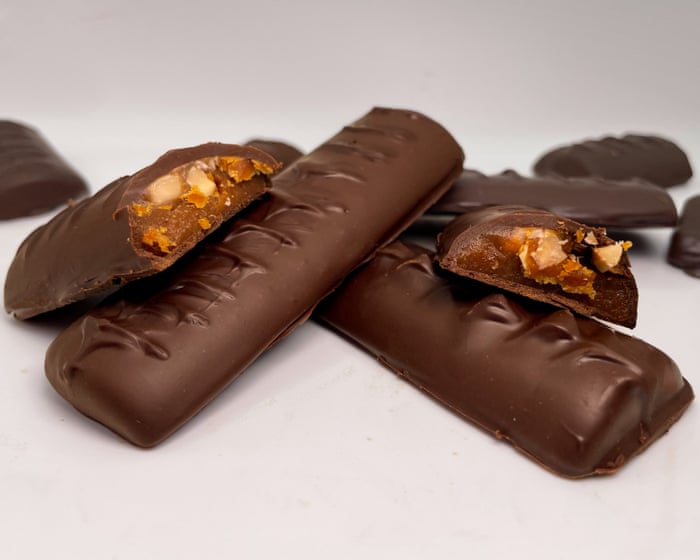When you think of sweets and desserts, rice probably isn’t the first thing that comes to mind. Yet a UK company is using it to produce chocolate without any cocoa. This is part of a growing movement where chocolate makers are turning to alternative ingredients and new methods to create more sustainable products and lessen their dependence on traditional cacao beans.
Rising costs have also played a role, prompting some brands to use “chocolate flavouring” or change their recipes to find cheaper ways to keep items on shelves. For instance, McVitie’s Penguin and Club bars, along with KitKat White and McVitie’s White Digestives, can no longer be labeled as chocolate because they don’t contain enough cocoa.
The climate crisis and deforestation have made cocoa farming increasingly unreliable and harmful to the environment. Meanwhile, global chocolate demand keeps climbing, straining supply chains even further.
“If you’re a company using chocolate today, you’re in crisis. Prices have more than quadrupled in three years. For some small businesses, that can mean the difference between surviving or not,” said Mark Golder, CEO of Win-Win, a maker of cocoa-free chocolate.
Golder’s company is developing chocolate alternatives. Instead of traditional cacao beans, it uses fermented grains and legumes like rice to mimic the taste, texture, and melting quality of real chocolate. Their process is similar to conventional chocolate production, involving steps such as fermentation and roasting.
According to Golder, interest in chocolate alternatives has surged as prices rise. “There’s been an explosion in interest over the last 18 months. We’re getting inquiries constantly from customers across Europe and beyond,” he noted.
“The world loves chocolate, but cacao trees are struggling. Climate change is reducing yields year after year, and about 75% of the world’s cocoa comes from Ghana and Ivory Coast, where deforestation and child labor remain serious problems.”
Golder explained that rice is the base ingredient, which often surprises people. Through fermentation, his company develops the complex flavor profile of chocolate. “We then combine the fermented base with other ingredients—carob, fats, and sugars—and use standard chocolate-making methods. The final product looks, tastes, and melts just like chocolate,” he said.
Other companies are also exploring innovative ways to produce chocolate. Swiss manufacturer Barry Callebaut has teamed up with Zurich University of Applied Sciences to work on cell-cultured chocolate, grown from cacao plant cells in a lab. These cells generate the same flavors and fats as real chocolate, without the need for cacao trees.
Germany’s Planet A Foods, creator of the ChoViva brand, uses roasted and fermented oats and sunflower seeds to replicate chocolate’s taste and texture without any cocoa. The company claims its method cuts carbon emissions by up to 90% and uses 90% less water than traditional chocolate production. With partnerships including Aldi and Lidl, Planet A has increased its output to over 10,000 tonnes a year as European demand grows.
In the US, California startup Voyage Foods has developed a cocoa-free product from grape seeds, sunflower protein, and shea butter. The company has secured over $40 million in funding to expand its operations and supply manufacturers.
Professor Tim Spector, co-founder of the UK health and nutrition company Zoe, commented, “Chocolate alternatives made without cocoa, including lab-grown versions, are part of an exciting new field of food innovation that’s better for the planet. For example, ChoViva ferments sunflower seeds to imitate the flavor and aroma of cacao, which is genuinely thrilling.”He added: “When it comes to nutrition, a new process doesn’t necessarily mean a healthier product. We know that the fat in chocolate, even though it’s saturated, can be beneficial when you eat a piece of dark chocolate, for instance. Right now, it’s unclear whether these new ‘chocolate-like’ alternatives will offer the same health benefits. Minimally processed cacao is packed with bioactive compounds like flavanols, which are great for gut health, blood pressure, and heart health.”
Spector noted that dark chocolate and raw cacao powder are “genuinely healthy foods to include in your diet,” but he warned against assuming that “cocoa-free or lab-grown automatically means better in every way.”
“These new types of chocolate may be better for the environment, but for your health, the best choice is still high-quality dark chocolate produced with good manufacturing practices.”
I should cocoa: treats ranked by cocoa content
Confectionery fans were disappointed this week to learn that lunchbox favorites McVitie’s Penguin and Club bars are no longer considered real chocolate, as their coatings have been downgraded to “chocolate flavour.”
The biscuits can’t be called chocolate anymore because they now contain more palm and shea oils than cocoa. The recipes were quietly changed earlier this year as ingredient costs rose and manufacturers sought cheaper ways to keep the products on shelves.
According to the latest cost of living data, the price of chocolate for shoppers increased by 15.4% in the year to August. Cocoa prices have more than doubled over the past two years due to poor harvests in West Africa, including Ghana and Ivory Coast, putting ongoing pressure on manufacturers.
So which brands have the highest cocoa content, and which are closer to the legal minimum? Below, we’ve ranked a selection of popular chocolate bars by their cocoa content, from dark to milk chocolate, based on manufacturer information and UK regulations.
Green & Black’s Organic 85% dark chocolate bar
This bar contains 85% cocoa solids, well above the UK minimum requirement of 35% for dark chocolate. A 90g bar typically costs £2.75 and is certified organic and Fairtrade. Other premium options include Montezuma’s Lordy Lord Cocoa Nibs dark chocolate bars, with 70% cocoa solids.
Aldi Dairyfine dark chocolate bar
Aldi’s Dairyfine dark chocolate contains 55% cocoa solids and is sold in a 200g bar for £1.85. It includes cocoa paste, cocoa butter, and emulsifiers, placing it above the legal threshold for dark chocolate.
Hotel Chocolat Milk Chocolate Slab
This 100g slab contains 40% cocoa solids and is priced at £5.45. The company highlights its higher cocoa content in advertising, noting that most other premium milk chocolates have cocoa in the 30% range.
Tony’s Chocolonely milk chocolate bar
The 180g bar contains 32% cocoa solids, exceeding the UK legal minimum for milk chocolate (25% dry cocoa solids and 14% dry milk solids). It usually retails for £4.50. The company’s CEO has mentioned that prices may rise if cocoa costs continue to increase.
Cadbury Dairy Milk
According to a 2024 survey by the Grocer magazine, Cadbury Dairy Milk is the UK’s favorite chocolate brand. A 95g bar contains 20% cocoa solids, meeting the legal minimum for milk chocolate. It sells for about £1.45 and contains milk solids, sugar, cocoa butter, cocoa mass, and emulsifiers.
McVitie’s chocolateMcVitie’s Dark Chocolate Digestives have a 30% dark chocolate coating, containing both cocoa mass and cocoa butter. This is a higher percentage than many other popular biscuits. A 226g pack is priced around £2.25.
The classic debate continues over whether McVitie’s Jaffa Cakes are biscuits or cakes. Officially, they contain 19% dark chocolate, which is on the lower end for chocolate biscuits. The dark chocolate includes cocoa, sugar, and other components, but the exact cocoa percentage isn’t specified. A pack of 10 costs about £1.25.
Oreo cookies use Dutch-processed cocoa powder in their chocolate wafers, which are about 4.5% cocoa. This type of cocoa is alkalized to reduce acidity, giving it a smoother taste and darker appearance. The powder is made from cocoa solids with most of the fat removed. A 154g pack sells for £1.30.
Wagon Wheels feature a 24% chocolate-flavored coating made with fat-reduced cocoa powder. Because of the low cocoa content, they don’t qualify as chocolate under UK regulations. A six-pack is available for £1.35.
Frequently Asked Questions
Of course Here is a list of helpful and clear FAQs about what happens when chocolate becomes too expensive
General Questions
1 Why is chocolate getting so expensive
Chocolate prices rise due to factors like poor cocoa harvests from climate issues higher farming and transportation costs and increased global demand
2 What do people typically use as a chocolate substitute
Common substitutes include carob cocoa powder mixed with oil or butter and chocolateflavored baking chips that use cheaper ingredients
3 What is carob and how is it different from chocolate
Carob is a sweet powder made from the pods of the carob tree Its naturally sweeter than cocoa contains no caffeine and has a milder maltlike flavor
Practical Tips Alternatives
4 Whats the easiest chocolate alternative I can find at the store
Look for chocolateflavored candy melts or baking chips They are often much cheaper than real chocolate and work well in recipes like cookies and trail mix
5 Can I use cocoa powder instead of a chocolate bar
Yes You can often substitute 3 tablespoons of cocoa powder plus 1 tablespoon of a fat for every 1 ounce of unsweetened baking chocolate in a recipe
6 Are there any healthy alternatives to chocolate
Yes options like carob cacao nibs or even adding spices like cinnamon and nutmeg to recipes can provide flavor and antioxidants without the high cost of chocolate bars
7 How can I make my own budgetfriendly chocolatelike treat at home
A simple recipe is to mix cocoa powder a little powdered sugar coconut oil and a pinch of salt Melt it together pour it into a mold and let it set in the fridge for a homemade chocolate bar
Deeper Questions Considerations
8 Do chocolate alternatives taste the same
No most alternatives have a different flavor profile Carob is sweeter and less bitter while cocoa powder mixtures might lack the creamy mouthfeel of highquality chocolate Its about finding a flavor you enjoy not a perfect copy
9 What are some unexpected or creative alternatives people use
Some people get creative by using ingredients like beet puree in brownies for moisture and color black beans in fudgy desserts or even spices like




